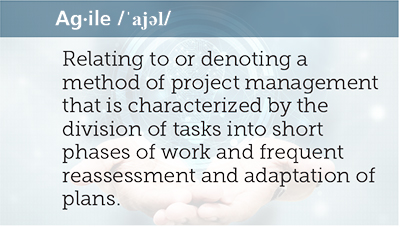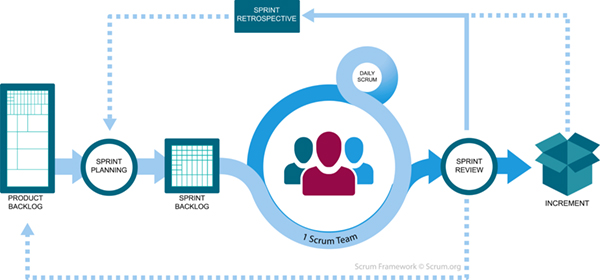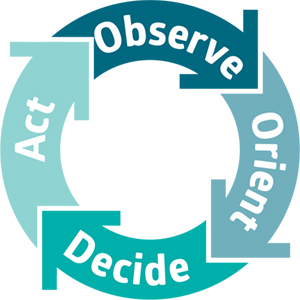Seven Deadly Risks of Innovation (and How Agile Mitigates Them)
SCOR's Agile teams collaborate across business functions to make SCOR an innovative, customer focused, Agile organization.
19 avril 2023

While several major insurers have undertaken Agile transformations in the last few years, much of the industry still lags behind in their adoption of Agile practices and methodologies. Many in the Agile community believe this is due to a traditional industry focus on risk avoidance and mitigation and that the insurance industry as a whole still views a transition to Agile as too much risk for not enough benefit.
However, when we look at the future of Life insurance, we can clearly see that companies who master the art of product innovation are the ones who will ultimately be successful in the long term.1 And when it comes to innovation, far from introducing risk, Agile methodologies actually help mitigate risk in a variety of ways!

So let’s talk about the seven biggest risks that accompany new product innovation and how Agile helps us avoid them.
1. The risk of undesirable products
A product can be undesirable for many reasons. Maybe you built the wrong thing, or perhaps you built the thing that was right for some other group but not your customers. The end result is the same in any scenario: you’ve created a product that your customers are not interested in buying.
Agile methodologies like Scrum (Figure 1)2 build three key elements of empiricism into every aspect of their framework: Transparency, Inspection and Adaptation. Using Scrum, teams build their product iteratively and incrementally, checking in frequently with internal stakeholders and external clients along the way, gathering feedback to ensure that what they are building is truly meeting the customer’s needs and desires.
Figure 1 - SCRUM Framework

2. The risk of being late to market
Say you do manage to design a product that you know your customers will love. What happens if your competitor gets their version to market before you do? Not being able to decide and execute fast enough is almost as bad as not knowing what to build at all.
Agile teams use prioritized Product Backlogs3 and work in short, iterative cycles (often called Sprints) to maximize their ability to react to a quickly changing market and close the OODA (observe, orient, decide, act) Loop4 on their competitors (Figure 2).
Figure 2 - OODA Loop

3. The risk of missed deadlines
Every team wishes they had a crystal ball that would tell them exactly how long it’s going to take to design and build a new product, how complex the work will be and what road bumps they’ll run into along the way.
Sadly, there are no crystal balls. But Agile teams have the next best thing: daily points of inspection and adaptation built into their process in the form of Daily Standup5 meetings. Agile teams also use the concept of Sprint Velocity6 to know on average how much work their team is capable of doing every two weeks, which allows them to predictably tell their stakeholders when an increment of work is likely to be finished.
4. The risk of stagnation
The world (and the Life insurance market specifically) is rapidly changing. How do we ensure that our teams are keeping abreast of the latest advances in information, process and technology and not just operating on a “same as last year” mentality, accruing technical debt?
The answer? Agile Retrospectives7. The practice of meeting at the end of each two-week iteration as a team to reflect on what went well and what areas could use some work helps develop and support a culture of continuous improvement that ensures the team does not stagnate or plateau, the focus being what can be made better every two weeks.
5. The risk of disappearing workforce
The world of work is changing. Maintaining an organization of highly skilled, highly engaged employees is becoming more vital than ever and also more difficult. According to the latest Gallup Poll8, “A record 47% of the workforce says now is a good time to find a quality job, and more than half of employees (51%) are searching for new jobs or watching for openings.” Three of the biggest reasons employees list for choosing to leave a position are bad management, company culture and work-life balance.
If only there were a framework out there that focused on self-organizing teams who collaborate to achieve their goals at a sustainable pace that allows for work-life balance. Good news, there is. Once again, Agile provides, by building a focus on self-organizing teams and sustainable pace into its core9.
6. The risk of waste
When designing the Toyota Production System in the late 1950s, Taichii Ohno, the father of Lean Manufacturing, identified “Muda,” the concept of waste, as one of the three main impediments to a company’s successful operation (the others being “Mura,” inconsistency, and “Muri,” overburden)10. He wanted to help Toyota conserve resources by eliminating waste in its processes.
Because Agile methodologies are the spiritual successor to Lean practices, Agile teams focus on designing the simplest possible solution that meets clients’ needs and prioritizing the highest value work first in their Backlogs11 to reduce the risk of wasting time and money building features or functionality that the clients don’t ultimately need or want.
7. The risk of groupthink
In our modern market, diversity of thought and experience is an organizational advantage that companies need to have. Lack of diversity can lead to missed opportunities at best and fundamentally bad product design at worst. There must be a variety of voices in the room, and those voices must feel empowered to make themselves heard12.
Agile teams are designed to be cross-functional and self-organized, bringing together team members with diverse skill sets and empowering them to take full ownership of every aspect of product design as well as hold each other accountable to their commitments. Agile won’t magically make your team more diverse, but it is designed to make sure every member of a diverse team feels heard and valued.
Conclusion
The insurance market is changing, and the future of our industry changes along with it. The companies that survive in this brave new data-driven, customer-centric world will be the ones that master the innovation game13. And when it comes to new product development, Agile teams build better products and deliver them sooner. Sure, you could stick with the same old sequential process your teams have had for decades, but why take the risk?
Want to know more? SCOR has seasoned Agilists ready to help. From new product development to underwriting to actuarial and operational work, our Agile teams collaborate across business functions to make SCOR an innovative, customer focused, Agile organization. Contact me directly if you’d like to engage our Agile Process Optimization team for information or training.
References
- http://go.cakeandarrow.com/millennials-modern-insurance-report
- https://www.scrumalliance.org/about-scrum/overview
- https://www.scruminc.com/product-backlog/
- https://en.wikipedia.org/wiki/OODA_loop
- https://www.scruminc.com/daily-scrum/
- https://www.scruminc.com/velocity/
- https://www.scruminc.com/retrospectives/
- https://www.gallup.com/workplace/238085/state-american-workplace-report-2017.aspx
- https://scrumguides.org/scrum-guide.html#team-dev
- https://en.wikipedia.org/wiki/Toyota_Production_System
- https://agilemanifesto.org/principles.html
- https://open.nytimes.com/why-having-a-diverse-team-will-make-your-products-better-c73e7518f677
- https://hbr.org/1986/01/the-new-new-product-development-game